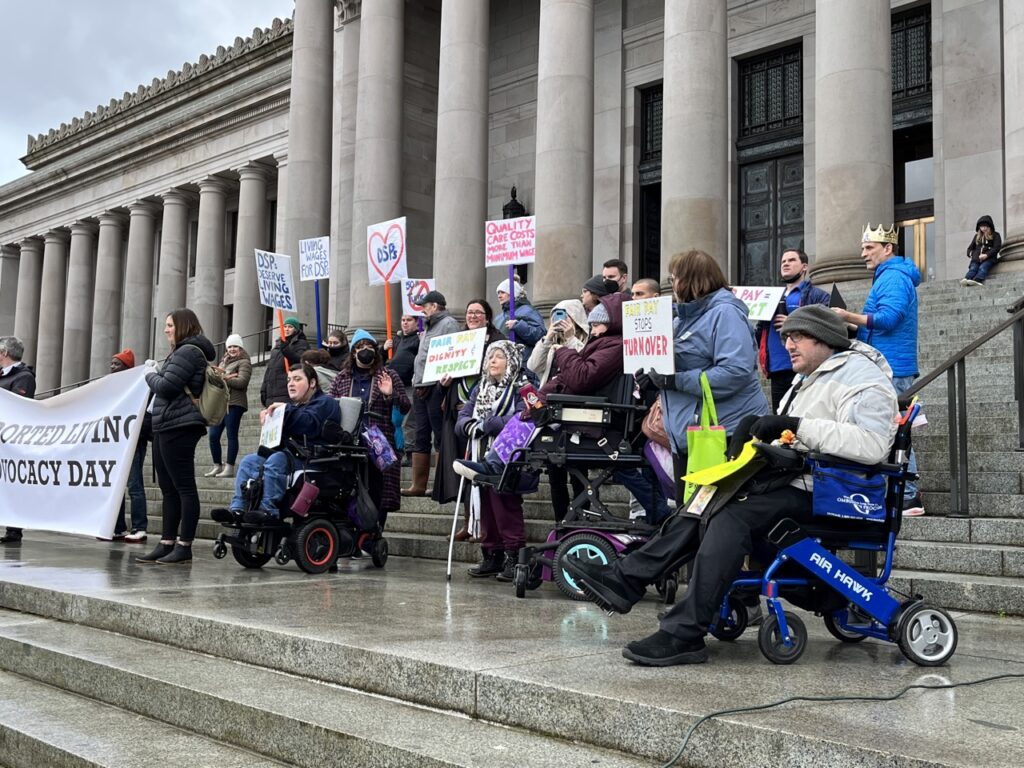
Advocates for people with intellectual and developmental disabilities rallied on the state capitol steps on Jan. 17. The group asked for rate increases for support staff and more funding for affordable housing. (Laurel Demkovich/Washington State Standard)
Providers of supported living services for people with intellectual and developmental disabilities are asking the Legislature for more funding to increase wages in an increasingly difficult-to-staff field.
People with disabilities can sometimes require intensive 24/7 care to help them live as independently as possible. Those who meet certain eligibility guidelines can qualify for in-home or group home care with costs covered by the state. But workers who provide these services, known as direct support professionals, often earn low pay, leading to high turnover, staff shortages and long waitlists.
Advocates are asking lawmakers to increase rates for these workers by 9.5% in both 2026 and 2027, which would cost the state roughly $99 million a year. That’s based on recommendations from a 2023 Department of Social and Health Services rate study report that found providers were severely underpaid compared to living wage benchmarks. At the time, the average hourly wage for a direct support professional was $20.12.
“Pay is one of the most needed things to stabilize supported living,” said Randy Hauck, executive director at Community Living, a nonprofit that provides supportive living services.
Most of the funding for direct care professionals comes from Medicaid. The money flows mostly through the Department of Social and Health Services Developmental Disabilities Administration which determines the rate at which staff get paid based on need and available funding.
The Department of Social and Health Services has not submitted a 2025 budget request to Gov. Jay Inslee for the rate increase. Other efforts to secure the funding could run into a roadblock as lawmakers are facing a deficit over the next four years estimated to be in the $10 billion to $12 billion range.
Washington has about 14,000 direct care professionals who serve about 4,600 people. But the turnover rate in this field is high, currently around 37%. That can be especially problematic for people with developmental disabilities who rely on consistent relationships.
“If you bring in 10 people that you’re training, you look around the room and know three or four of them are going to be gone by the end of the year,” Hauck said.
Aaron Pickus, a communications specialist for supported living groups, said there was about a 388-person waitlist with people who were approved for services but can’t get a placement as of October. Most of those – about 185 people – are looking to move out of a family home. Another 54 are in state-run institutions, and another 36 are in a hospital or state-run psychiatric hospital.
Once someone is approved for benefits, it can take more than 100 days for them to get placed.
The more time someone spends in a state-run institution, the higher the cost can be for the state, Pickus said.
“This underscores a need to invest taxpayer dollars as efficiently as possible so that those with intellectual and developmental disabilities are able to find a home that best fits their needs in the community,” Pickus wrote in an email.
It may be an expensive request now, but pushing off a pay increase will be more expensive for the state in the long run, Hauck said. The rate study report, which used 2022 data, determined providers were about 10% underfunded. With inflation, that’s now about 18% – hence the 9.5% increases advocates are asking for in each of the next two years.
“The state could save lots of money if they put a little bit of money into making sure we have staff,” Hauck said.
It’s the second year in a row that care providers and their allies have asked for this funding. Last year’s request resulted in a 2.5% increase – or about a 50-cent-per-hour bump in pay.
Lawmakers tend to be inconsistent with funding increases for supported living, Hauck said. Some years, they’ll get a big boost, but then for years afterward, they will only get meager increases like last year’s 2.5% increase.
With the multi-billion dollar deficit looming, Hauck acknowledged the request may be difficult to get through.
Budget leaders in the governor’s office are already asking agencies to propose cuts in programs and services. Gov. Jay Inslee will release his budget proposal in mid-December. That will be the starting point that lawmakers use to write their budget by the end of the legislative session in April.

